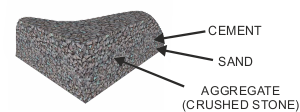| CLICK HERE FOR INDEX PAGE | ||
| REVISION CARDS - COMPOSITE MATERIALS | ||
| V. Ryan © 2013 | ||
| PDF FILE - CLICK HERE FOR PRINTABLE WORKSHEET | ||
|
WHAT ARE COMPOSITE MATERIALS ? Composite materials, also called Composites. Composed of two or more materials, that have different properties. The materials are bonded together and their properties are combined. Composite materials combine the physical properties of the individual materials they are made up of, forming a superior material. KEVLAR - REINFORCED CONCRETE PLYWOOD - GLASS REINFORCED FIBRE CARBON FIBRE |
COMPOSITE MATERIALS - CONCRETE  Used in construction, roads, brick laying, building and many more. Concrete is composed of a number of materials, that combine to form this versatile building material. Most concrete is made up of Portland Cement, aggregates (gravel, crushed stones) and sand. Water is added to the mix. |
|
|
COMPOSITE MATERIALS -
STEEL REINFORCED CONCRETE  Concrete is weak when put under tension. If reinforced with steel rods, it is can withstand tensile forces. Reinforced concrete has long steel rods passing through its length, adding great strength to the final composite material. Able to resist tensile forces. Used for bridge building, skyscrapers and general large scale construction. |
COMPOSITE MATERIALS GLASS REINFORCED PLASTIC(GRP) Composed of strands of glass and woven to form a flexible fabric. Placed in a mould and polyester resin is added, followed by a catalyst (to speed up the reaction). Allowed to dry/cure. The resulting material is strong and light. Can be sanded and painted. Used for canoes, car bodies, small swimming pools, water tanks, surfboards, small boat hulls.  |
|
|
COMPOSITE MATERIALS CARBON FIBRE REINFORCED POLYMER (CFRP) Carbon fibre is woven into a textile material. Epoxy resin is added and allowed to cure. The resulting material is very strong and light. An improvement on glass fibre reinforced plastic, although much more expensive. Uses; Aerospace, expensive sports cars, competition bicycles and motorbikes.  |
COMPOSITE MATERIALS - KEVLAR Kevlar® is a liquid, converted into a fibre (called aramid fibres) and woven into a textile material. Extremely strong, lightweight, corrosion and heat resistant. Has a high tensile strength to weight ratio, far exceeding steel, carbon fibre and specialist alloys. Uses when combined with other materials: bullet proof jackets, armour for military vehicles and planes. Formula 1 fuel tanks.  |
|
| QUESTIONS | ||
| 1. What is a composite material? | ||
| 2.How are the physical properties of a composite material superior that those of a single material? | ||
| 3. Describe one advantage of the composite ‘steel reinforced concrete’ over normal concrete? | ||
| 4. What composite material is used for the manufacture of canoes, car bodies, small swimming pools, water tanks, surfboards and small boat hulls? | ||
| 5. Describe the composition of the material you named above and its manufacture. | ||
| 6. What is CFRP? | ||
| 7. What are the physical properties of CFRP? | ||
| 8. What is Kevlar? Describe the physical properties and some practical applications of this composite material. | ||
| CLICK HERE FOR DESIGN PROCESS INDEX PAGE | ||